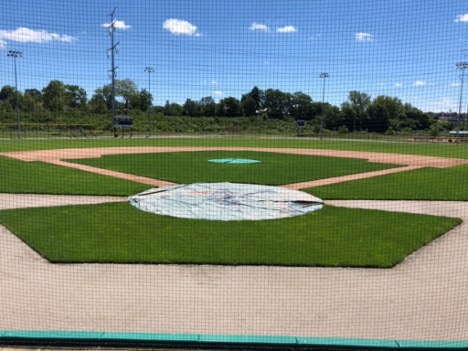Dormant seeding is an often forgotten practice among many turf managers, who view this as a last resort option when traditional fall seeding has failed. In some segments of the turf industry, particularly sports field management, dormant seeding is a much more common practice. With fall sports fields that finish play late (football especially), this can often be the best time to reseed for the following year without waiting until late spring.
Dormant seeding is the practice of applying seed to thin turf stands (lawns, sports fields, or golf courses) during times of the season when germination will not occur. Most cool-season turfgrasses require soil temperatures of at least 50°F to germinate, so pay close attention to when your local soils fall below this threshold for what forecasts to be the rest of the year.
With dormant seeding late in fall, the idea will be to have seed in place next spring so that it can take advantage of early spring weather, which for most of us includes warming soil temperatures and abundant soil moisture. Dormant seeding (while soils are still firm in late fall) improves seed placement while minimizing the risk of mess when utilizing slit-seed, aeration, or other mechanical forms of cultivation that maximize seed-to-soil contact. Many of these practices are tougher to accomplish in cool, wet spring conditions or can cause damage to neighboring areas due to the weight of machines on softened soils.
In areas that have heavy snow cover in winter, these practices are typically timed in November or December. However, in the transition zone, this practice can occur even later, with applications made in January or February at times.
One of the most successful dormant seeding applications in my career took place in Cincinnati in mid-February. My staff dormant seeded Advanced TFR into all of the Reds Urban Youth Academy fields during a period where soil temperatures were in the low 40s. This timing was our best opportunity to convert from Kentucky bluegrass to a lower input, high-performing turf-type tall fescue facility without limiting play in season.
One commonly overlooked step with dormant seeding is spring pre-emergent applications, which will need to be altered or delayed to best protect seed germinating in spring. Avoid pre-emergent herbicides such as prodiamine and Dimension in early spring, as they can damage emerging seed during March and April. Lebanon 21-22-4 starter fertilizer with mesotrione herbicide is an excellent option for these applications. It will protect the germinating plants from many broadleaf weeds and crabgrass that will germinate at the same temperatures. Fertilizers with Dimension are great options after seed has established in late spring, as they continue control of broadleaf weeds and crabgrass for the season while offering post-emergent control of any crabgrass that has managed to invade.
For more information about dormant seed best management practices, contact your local Advanced Turf representative for the best timing and seed selection for your geography.












